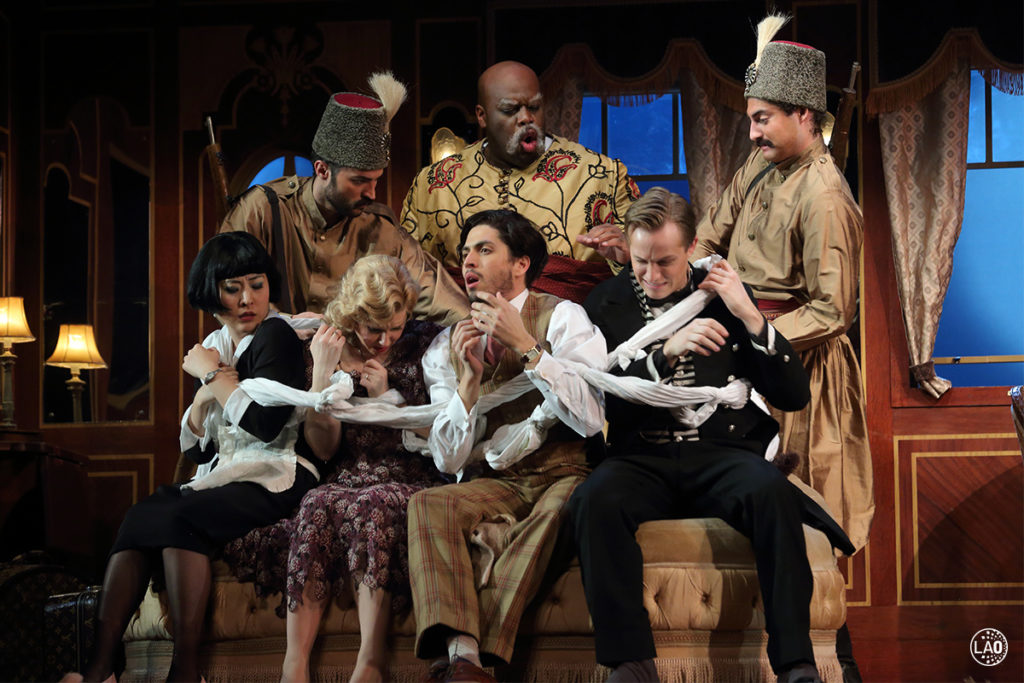High up on a shelf in James Conlon’s upstairs office within the Dorothy Chandler Pavilion sit two Grammy statuettes, zinc-alloy miniature replicas of old gramophones from the acoustical age of recording.
They represent the classical album and opera recording awards for Los Angeles Opera’s DVD of Kurt Weill’s “Rise and Fall of the City of Mahagonny,” made in 2007 during Conlon’s first season as the company’s music director.
“They’re not just mine; they’re everybody’s,” Conlon says, pointing to the awards as he refers to the entire company. The maestro is understandably tired, having just finished rehearsals for not one but two operas, Mozart’s “The Abduction From the Seraglio” and Richard Strauss’ “Salome,” which opens Feb. 18.
This weekend will be eventful too: Conlon and L.A. Opera are up for two Grammys (opera and engineering) for a CD of John Corigliano’s “The Ghosts of Versailles,” recorded by the Dutch PentaTone label in early 2015. Like most opera recordings these days in an era of escalating expenses, it was patched together from live performances.
“The Ghosts of Versailles” will compete with two other CDs (Santa Fe Opera’s recording of Jennifer Higdon’s “Cold Mountain” and Yannick Nézet-Séguin’s recording of Mozart’s “The Marriage of Figaro”) and two DVDs (the Royal Opera’s production of Szymanowski’s “King Roger” and the Salzburg Whitsun Festival production of Handel’s “Giulio Cesare” with mezzo-soprano Cecilia Bartoli).
Conlon, who regains his usual spark as the interview progresses, points out that pitting audio recordings against videos is an inaccurate comparison because “they are definitely two different things.”
“There are fewer and fewer CDs of complete operas being made now compared to the great height of the recording era,” he says. “It’s become much more DVD because most of the public wants to see the whole thing, wants to see it as well as hear it. It seems to me that given the popularity of videos, that puts the CDs at a disadvantage.”
A related issue is that studio recordings of opera are largely disappearing, replaced by less expensive live-performance recordings. For the latter there’s no need to book studio time or schedule additional rehearsals or hope that busy singers are available on additional dates.
On winning the two Grammys in 2009, he says: “It’s a nice feeling of recognition. All artists like that. I don’t know if it affects sales. It would not affect my opinion of somebody if they did or did not get it. But I think the public is impressed by it.”
It is fitting that the Recording Academy would recognize Conlon’s work on “Mahagonny” and “Ghosts” given that, from the outset of his recording career, Conlon has veered toward works that have been under-recorded or in some cases never recorded. In the mid-1980s, he recorded a lot of unusual Liszt with the Rotterdam Philharmonic for the Erato label: the “Faust” and “Dante” symphonies, “Legends of St. Francis” and the oratorio “Christus.”
Conlon went on a spree in the 1990s for EMI in the service of his enthusiasm for Alexander von Zemlinsky, recording nine albums that have been a major boost for the Zemlinsky revival of the last three decades. During Conlon’s tenure at L.A. Opera, four productions of obscure Recovered Voices operas — Zemlinsky’s “Der Zwerg,” Viktor Ullmann’s “The Broken Jug,” Walter Braunfels’ “The Birds” and Franz Schreker’s “Die Gezeichneten” — made it onto DVD or CD.
“I’ve never made a recording of a Beethoven symphony or a Brahms symphony,” Conlon says. “Does the world need another Brahms cycle? Not really.
“When I was in Cologne and I became interested in the whole era of what we now call the Recovered Voices, that was an open book because so little had been done. Decca had made that fantastic Entartete Musik [Degenerate Music] series but that’s not enough, you know? As I got started, as I had the satisfaction of doing these works, I said, come on, let’s go, let’s record everything he [Zemlinsky] wrote for orchestra. Let’s try to record all the operas. Well, we only got three out of eight, but we got them and they’re there.”
At this late date, are there any corners of the repertoire that have yet to be fully represented on recordings?
Recovered Voices is nowhere near where it should be, Conlon says. “I mean, there are hundreds of works, at the very least, that have not been recorded, or recorded once inadequately. Making one recording of a work does not establish a work.”
Also on his list: the rest of the Zemlinsky cycle. For his own pleasure, Schreker’s “Der ferne Klang.” (“I haven’t studied the later operas, but they interest me a great deal,” he says.) Also the Erwin Schulhoff symphonies and concerti.
These days, Conlon’s preferred medium of listening is his iPod Classic, whose large storage capacity is useful for someone constantly on the go. He does, however, miss the idea of a record store. Online, you have to know what you’re searching for, whereas in a shop you can browse and be pleasnatly caught off-guard by something you didn’t know existed, something that piques your curiosity.
Conlon is also ambivalent about sound quality when listening for information or recreation. “I’m interested in the substance of the music-making, and it does bother me when I see lots of discussion of the technology or the latest features of sound because I think it distracts from the essence,” he says. “I would rather listen to a badly recorded or vintage recording of Toscanini with the NBC Symphony than some recent thing, in a recording of great quality, of a mediocre performance.”


